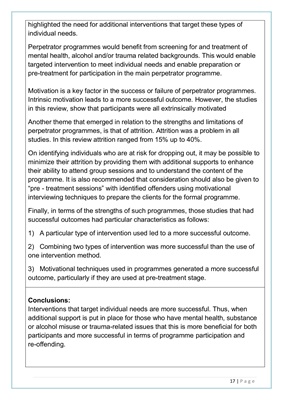
17 | P a g e
highlighted the need for additional interventions that target these types of
individual needs.
Perpetrator programmes would benefit from screening for and treatment of
mental health, alcohol and/or trauma related backgrounds. This would enable
targeted intervention to meet individual needs and enable preparation or
pre-treatment for participation in the main perpetrator programme.
Motivation is a key factor in the success or failure of perpetrator programmes.
Intrinsic motivation leads to a more successful outcome. However, the studies
in this review, show that participants were all extrinsically motivated
Another theme that emerged in relation to the strengths and limitations of
perpetrator programmes, is that of attrition. Attrition was a problem in all
studies. In this review attrition ranged from 15% up to 40%.
On identifying individuals who are at risk for dropping out, it may be possible to
minimize their attrition by providing them with additional supports to enhance
their ability to attend group sessions and to understand the content of the
programme. It is also recommended that consideration should also be given to
"pre - treatment sessions" with identified offenders using motivational
interviewing techniques to prepare the clients for the formal programme.
Finally, in terms of the strengths of such programmes, those studies that had
successful outcomes had particular characteristics as follows:
1) A particular type of intervention used led to a more successful outcome.
2) Combining two types of intervention was more successful than the use of
one intervention method.
3) Motivational techniques used in programmes generated a more successful
outcome, particularly if they are used at pre-treatment stage.
Conclusions:
Interventions that target individual needs are more successful. Thus, when
additional support is put in place for those who have mental health, substance
or alcohol misuse or trauma-related issues that this is more beneficial for both
participants and more successful in terms of programme participation and
re-offending.